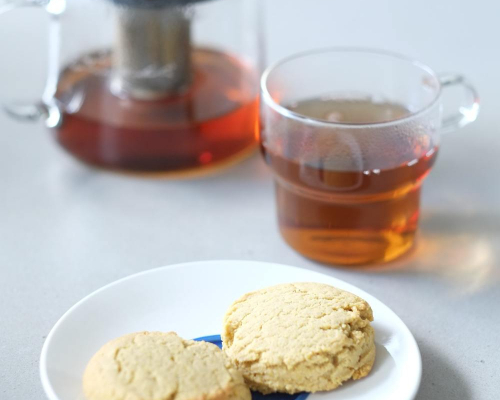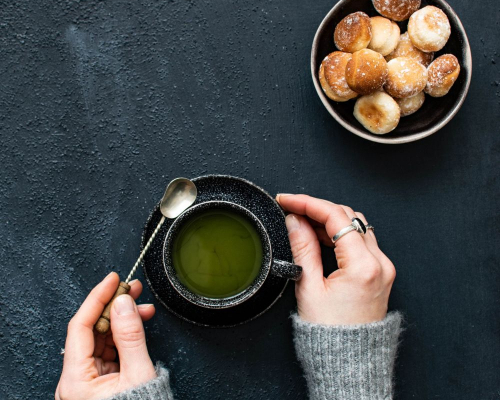Wondering what the deal is between Hojicha vs Matcha?
Well, wonder no more.
This quick guide will teach you all you need to know about the two teas. The background. The similarities. And of course, the differences.
So, let’s jump in.
Intro to Hojicha
Hojicha tea is… a roasted green tea with a brown color, uniquely roasted aroma, and smokey flavor.
The roasting process removes the bitterness of regular Japanese green tea. Hojicha typically roasts lower-grade green teas because they are usually more bitter. The special roasting process softens the flavor and turns it into something that more people can enjoy.

In Japan, hojicha is enjoyed as an everyday tea. Hojicha contains less caffeine, so it is an ideal tea for those who have caffeine sensitivities or are trying to limit caffeine before bedtime.
It’s also become a popular flavor for desserts like cakes, cookies, and pudding. These days, you can also find hojicha in the form of lattes at many cafes and coffee shops.
Intro to Matcha
Matcha is a Japanese green tea that is turned into a powder.
It is typically much stronger and more intense in flavor than drinking green tea made from loose leaves. Matcha is brewed differently from regular tea because you are supposed to whisk the hot water and matcha powder together.

In Japanese culture, matcha is also the central part of the Japanese tea ceremony. Nowadays, matcha has become popular in many different contexts outside of the traditional Japanese tea ceremonies. You can find many types of matcha-based desserts and drinks like matcha lattes, ice creams, and cakes.
So, now that you know a bit about these types of Japanese tea…
Let’s compare.
Similarities between Hojicha vs Matcha
Green tea leaves
Both hojicha and matcha are considered Japanese green tea. So, both are made from green tea leaves. Hojicha is made from roasting green tea leaves, and matcha is made from making the green tea leaves into a powder.
Health Benefits form
Hojicha vs matcha health benefits are pretty much similar. Both teas are made from green tea leaves and contain the same properties and vitamins.
- May reduce inflammation
- Contains antioxidants
- Plenty of Vitamin A, C, E
- Both good for skin
- Good for heart health
- May lower risk of cancer
- Disclaimer: Please do not use this as medical advice for your personal situation and consult with doctors for confirmation.
Powdered form
You can find hojicha and matcha in a powdered form. Matcha is always a powder, but hojicha can be either a loose leaf or a powder. Powdered tea makes it easier to make into desserts and beverages.
Desserts and lattes
Hojicha and matcha can both be found in various desserts and lattes. Matcha works well in desserts because of its bitter umami flavor that works with sugar. Hojicha is also a great flavor in desserts because of the smokey roasted flavor. Some popular desserts include cakes, cookies, puddings, and even tiramisu.
Hot & Cold
Both teas can be enjoyed as hot or cold. Though on the traditional tea ceremony side of things, match is made hot.
Difference between Hojicha and Matcha
Now, what about the differences? Let’s take a look.
Caffeine content
Hojicha has less caffeine than traditional Japanese green tea.
However, matcha contains more because it is in a powdered form. Matcha is perfect if you need a tea that will get you your caffeine fix. But, if you need tea where you can relax, hojicha will work better for you.
In recent times, matcha has become popular because it can be an alternative for coffee. Instead of your morning cup of coffee, you can drink matcha which has less caffeine than coffee but more than black tea.
Occasion for drinking
Another major difference between hojicha and matcha is occasion.
Hojicha is an everyday tea that can be consumed whenever you feel like it.
On the other hand, matcha is associated with tea ceremonies. It is more of a special occasion to drink matcha.
Nowadays, some people will also drink matcha daily for its health properties and caffeine content. However, it’s still not a good idea to drink many cups of matcha per day because it is so intense and high in caffeine.
Brewing method
Matcha is typically brewed using hot water and a whisk. You’re supposed to mix the matcha so that you get air bubbles and create a frothy drink. Hojicha is brewed by steeping the loose leaf tea in hot water. Hojicha is unique because it requires a very high temperature for brewing. You can use freshly boiled water to make hojicha. On the other hand, matcha does best with slightly cooler water of about 80 degrees celsius.
Flavor
So, what about the hojicha vs matcha taste? They’re completely different.
Matcha has a strong and intense earthy flavor with a distinct bitterness. Hojicha is much milder and has a smokey roasted flavor. In addition, the powdered form of matcha creates a much thicker drink. Hojicha is watery when brewed normally as a loose leaf tea.
Production process
The production processes of the two teas are different because hojicha is made by roasting green tea. The green tea that is used is that of lower-grade. On the other hand, matcha uses premium green tea leaves that are harvested early. Matcha relies on high-quality leaves so that the powder can retain vibrant color and a rich umami flavor. With hojicha, the lower quality tea will shine again due to the roasting process that creates additional aromas and decreases bitterness.
Color
Another major difference is the color of the two teas. Matcha has a distinct green color, while hojicha is brown. One reason for matcha’s popularity in desserts and lattes is this unique natural color. With hojicha, it is a brown color due to the roasting of the tea. Hojicha lattes can be a great alternative to typical coffee lattes because they are still brown-colored but have less caffeine than coffee.
 |
 |
Back to You
Now you know a bit about hojicha vs matcha.
Which one is your favorite?
Leave a comment.
Team IJ